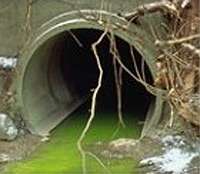Cultural eutrophication

Cultural eutrophication is the process that speeds up natural eutrophication because of human activity.[1] Due to clearing of land and building of towns and cities, land runoff is accelerated and more nutrients such as phosphates and nitrate are supplied to lakes and rivers, and then to coastal estuaries and bays. Extra nutrients are also supplied by treatment plants, golf courses, and agricultural practices through the use of fertilizers. Human activities, including the ones previously listed, can be responsible for an increase in nutrients, therefore, cultural eutrophication is more pronounced in non-polar ecosystems which have higher levels of human activity.[2] Polar regions have less human activity and subsequently less cultural eutrophication.
One response to added amounts of nutrients in the aquatic ecosystem is the rapid growth of microscopic algae, also known as an algal bloom. In freshwater systems, the formation of floating algal blooms are commonly nitrogen-fixing cyanobacteria (blue-green algae). This outcome is favoured when nitrogen inputs are reduced and phosphorus inputs are increased.[3] Large amounts of algae reduce the amount of dissolved oxygen available in the water for other organisms, which increases fish mortality rates. These areas affected by algal blooms are known as dead zones, and are found where rivers empty into oceans.[4] Nutrient pollution is a major cause of algal blooming however, the excess nutrients also facilitate the growth of other aquatic plants. Following this, overcrowding occurs and plants compete for sunlight, space, and oxygen. Overgrowth of water plants also blocks sunlight and oxygen for aquatic life in the water, which threatens their survival. Increased competition for the added nutrients can cause potential disruption to entire ecosystems and food webs, as well as a loss of habitat, and biodiversity of species.[5]
The Experimental Lakes Area (ELA), Ontario, Canada is a fully equipped, year-round, permanent field station that uses the whole ecosystem approach and long-term, whole-lake investigations of freshwater focusing on cultural eutrophication. ELA is currently cosponsored by the Canadian Departments of Environment and Fisheries and Oceans, with a mandate to investigate the aquatic effects of a wide variety of stresses on lakes and their catchments.[6][7]
Sources of anthropogenic pollution
Raw sewage
The disposal of raw sewage into ocean waters is banned in many countries including the United States, but many developed countries such as Canada continue to pump untreated sewage waste into ocean waters.[8] This is a widespread and highly publicized issue ranging from west coast Victoria, British Columbia,[9] to east coast Nova Scotia.[10]
Agriculture
In order to match an increase in food demand, agricultural production relies heavily on the use of fertilizers to increase overall crop productivity.[11] These fertilizers contain high amounts of phosphorus and nitrogen, which results in excess amounts of nutrients entering the soil. The nutrients that are not absorbed by the plant leach out of the soil and enter freshwater systems, such as rivers. These nutrients can eventually end up in aquatic ecosystems, and are a contributor to increased eutrophication.[11]
References
- ↑ Cultural eutrophication (2010) Encyclopædia Britannica. Retrieved April 26, 2010, from Encyclopædia Britannica Online:
- ↑ Antoniades, Dermot; Michelutti, Neal; Quinlan, Roberto; Blais, Jules M.; Bonilla, Sylvia; Douglas, Marianne S. V.; Pienitz, Reinhard; Smol, John P.; Vincent, Warwick F. (2011-03-01). "Cultural eutrophication, anoxia, and ecosystem recovery in Meretta Lake, High Arctic Canada". Limnology and Oceanography. 56 (2): 639–650. doi:10.4319/lo.2011.56.2.0639. ISSN 1939-5590.
- ↑ Schindler, David W.; Hecky, R.E.; Findlay, D.L.; Stainton, M.P.; Parker, B.R.; Paterson, M.J.; Beaty, K.G.; Lyng, M.; Kasian, S. E. M. (August 2008). "Eutrophication of lakes cannot be controlled by reducing nitrogen input: Results of a 37-year whole-ecosystem experiment". Proceedings of the National Academy of Sciences of the United States of America. 105 (32): 11254–11258. doi:10.1073/pnas.0805108105. PMC 2491484.
- ↑ Ricklefs, R.; Relyea, R.; Richter, C. (2015). Canadian edition: Ecology - the Economy of Nature. Freeman and Co.
- ↑ Rabalais, NN (Mar 2002). "Nitrogen in aquatic ecosystems". AMBIO - A Journal of the Human Environment. 31 (2): 102-112.
- ↑ Schindler, David William (2009). "A personal history of the Experimental Lakes Project" (PDF). Canadian Journal of Fisheries and Aquatic Sciences. 66 (11): 1837–1847. doi:10.1139/f09-134.
- ↑ Schindler, David W., Vallentyne, John R. (2008). The Algal Bowl: Overfertilization of the World's Freshwaters and Estuaries, University of Alberta Press, ISBN 0-88864-484-1.
- ↑ "Pollution of the Ocean by Sewage, Nutrients, and Chemicals - river, sea, oceans, percentage, types, system, plants, source, marine, oxygen, human, Pacific". Waterencyclopedia.com. Retrieved 2017-04-30.
- ↑ Roshini Nair (2016-09-14). "Decades of dumping raw sewage is killing Victoria's ocean floor, diver claims - British Columbia - CBC News". Cbc.ca. Retrieved 2017-04-30.
- ↑ Elizabeth Thompson (2016-12-12). "Billions of litres of raw sewage, untreated waste water pouring into Canadian waterways - Politics - CBC News". Cbc.ca. Retrieved 2017-04-30.
- 1 2 Huang, Jing; Xu, Chang-chun; Ridoutt, Bradley; Wang, Xue-chun; Ren, Pin-an (August 2017). "Nitrogen and phosphorus losses and eutrophication potential associated with fertilizer application to cropland in China". Journal of Cleaner Production. 159: 171–179. Retrieved 23 October 2017.